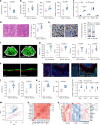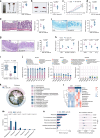Bifidobacterium animalis subsp. lactis A6 ameliorates bone and muscle loss via modulating gut microbiota composition and enhancing butyrate production
- PMID: 40000617
- PMCID: PMC11862215
- DOI: 10.1038/s41413-024-00381-1
Bifidobacterium animalis subsp. lactis A6 ameliorates bone and muscle loss via modulating gut microbiota composition and enhancing butyrate production
Abstract
Systematic bone and muscle loss is a complex metabolic disease, which is frequently linked to gut dysfunction, yet its etiology and treatment remain elusive. While probiotics show promise in managing diseases through microbiome modulation, their therapeutic impact on gut dysfunction-induced bone and muscle loss remains to be elucidated. Employing dextran sulfate sodium (DSS)-induced gut dysfunction model and wide-spectrum antibiotics (ABX)-treated mice model, our study revealed that gut dysfunction instigates muscle and bone loss, accompanied by microbial imbalances. Importantly, Bifidobacterium animalis subsp. lactis A6 (B. lactis A6) administration significantly ameliorated muscle and bone loss by modulating gut microbiota composition and enhancing butyrate-producing bacteria. This intervention effectively restored depleted butyrate levels in serum, muscle, and bone tissues caused by gut dysfunction. Furthermore, butyrate supplementation mitigated musculoskeletal loss by repairing the damaged intestinal barrier and enriching beneficial butyrate-producing bacteria. Importantly, butyrate inhibited the NF-κB pathway activation, and reduced the secretion of corresponding inflammatory factors in T cells. Our study highlights the critical role of dysbiosis in gut dysfunction-induced musculoskeletal loss and underscores the therapeutic potential of B. lactis A6. These discoveries offer new microbiome directions for translational and clinical research, providing promising strategies for preventing and managing musculoskeletal diseases.
© 2025. The Author(s).
Conflict of interest statement
Competing interests: The authors declare no competing interests.
Figures






References
MeSH terms
Substances
Grants and funding
LinkOut - more resources
Full Text Sources
Other Literature Sources

